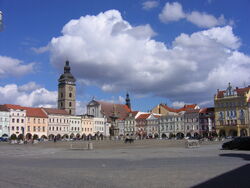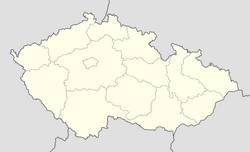| Main | Births etc |
|---|
| České Budějovice | |||
|---|---|---|---|
| — City — | |||
| City center square | |||
|
|||
| Coordinates: Coordinates: | |||
| Country | Czech Republic | ||
| Region | South Bohemian | ||
| District | České Budějovice | ||
| Area | |||
| • Total | 55.56 km2 (21.45 sq mi) | ||
| Elevation | 381 m (1,250 ft) | ||
| Population (2009) | |||
| • Total | 96,053 | ||
| • Density | 1,700/km2 (4,500/sq mi) | ||
| Time zone | CET (UTC+1) | ||
| • Summer (DST) | CEST (UTC+2) | ||
| Website | [http://www.c-budejovice.cz www.c-budejovice.cz | ||
České Budějovice (Czech pronunciation: [ˈtʃɛskɛː ˈbuɟɛjovɪtsɛ]; colloquially: Budějice or Budějce; German: Budweis or Böhmisch Budweis; Polish: Czeskie Budziejowice; often referred to simply as Budweis in English) is a city in the Czech Republic. It is the largest city in the South Bohemian Region and is the political and commercial capital of the region and centre of the Roman Catholic Diocese of České Budějovice and of the University of South Bohemia and the Academy of Sciences. The town is not to be confused with Moravské Budějovice in Moravia.
History[]
The city was founded by Hirzo, a knight of King Ottokar II of Bohemia, and was granted its municipal charter in 1265. The royal city was created as a platform of the king's power in South Bohemia and to counterbalance the powerful aristocratic House of Rosenberg, which died out in 1611. The city was traditionally a bulwark of the Catholics in the long-lasting religious conflicts in Bohemia.
The city was a German-speaking enclave from the 17th century until 1880. During the industrialization of the city, Czechs again became the ethnic majority. Until the Expulsion of Germans after World War II, the city contained a significant German minority (about 15.5% in 1930).
Some population figures: 1828: 6,800; 1832: 8,100; 1851: 15,200; 1880(the first to report nationality): 11,829 Germans and 11,812 Czechs; 1890: 11,642 and 16,585; 1900: 15,400 and 23,400; 1910: 16,900 and 27,300; 1921 (the first held under Czech rule): 7,415 and 35,800.[1]
Beer[]
Budějovice has long been well known for the beer brewed there since the 13th century. For a time the town was the imperial brewery for the Holy Roman Emperor, and Budweiser Bier (beer from Budweis) became,[2] along with Plzeň's Pilsener, one of the best-known lagers. Brewing remains a major industry.
The largest brewery, founded in 1895, is Pivovar Budějovický Budvar (Budweiser Budvar Brewery) which has legal rights to market its beer under the "Budweiser" brand name in much of Europe. The same product is also sold elsewhere under the names "Budvar" and "Czechvar" due to legal disagreements with Anheuser-Busch over the Budweiser brand. The American lager was originally brewed as an imitation of the famous Bohemian original, but over time has developed its own identity and attained remarkable commercial success. Anheuser-Busch has made offers to buy out the Czech brewing company in order to secure global rights to the name "Budweiser", but the Czech government has refused all such offers, regarding the Czech Budweiser name as a matter of national pride.
The oldest (founded in 1795) and second largest brewery was renamed to "Pivovar Samson", replacing its original German name, during the communist period. It also exported, mostly under the "Samson" and "Crystal" labels. Recently, they reacquired naming rights for Budweiser for Europe while offering "B. B. Bürgerbräu" in the US since 2005.
Geography[]
The city is in the center of a valley of the Vltava River, where the Vltava meets the Malše river.
Sights[]
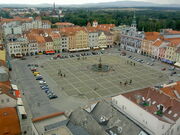
České Budějovice's town square: Naměstí Přemysla Otakara II (Přemysl Otakar II Square).
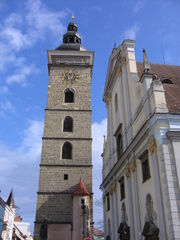
St. Nicholas Cathedral with the Black Tower on the opposite corner of the square
The old town preserves interesting architecture from Gothic, Renaissance, Baroque and 19th century period. This includes buildings around the large town square, the old town hall with murals and bronze gargoyles, and the town tower "Černá věž" ("Black Tower"). In the new town the Belle Époque Austro-Hungarian train station is notable. The most valuable historic building in České Budějovice is the Dominican convent with the Gothic Presentation of the Virgin Mary church on Piaristic Square. The horse-drawn railroad line connecting České Budějovice to Linz was the second oldest public line in continental Europe (after the St.Etienne-Andrexieux line in France), constructed from 1824 to 1832; mere traces of the line can be seen south of the city center.
The ruins of the home castle of the Czech national hero Jan Žižka, Trocnov, are located some ten kilometres (6 miles) southeast of the town. A bit further away (approximately 30 km), the town of Český Krumlov is another popular tourist destination in South Bohemia. In 1992, it was added to UNESCO list of World Heritage Sites.
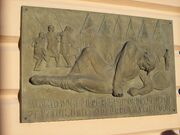
Plate commemorating the murder of mayor Ondrej Puklice in1467
Transport[]
Local buses and trolleybuses take passengers to most areas of the city. The city can be reached from other locations by inter-city buses and by train. Internationally, a direct railroad service connecting Prague with Zurich, via Linz and Salzburg, also makes a stop in České Budějovice.
People[]
It was the birthplace of:
- Adalbert Gyrowetz (Czech: Vojtěch Jírovec), Bohemian composer
- Karl Franz Leppa[3]
- Jaroslav Modrý, former NHL player, currently playing for HC Lasselsberger Plzeň
- Václav "Vinny" Prospal, ice hockey player for the New York Rangers
- Vladimír Remek, cosmonaut (also a first non-USSR, non-US citizen in space aboard Soyuz 28 in 1978)
- Karel Roden, actor
- František Straka, soccer player/coach
- Rolf Thiele, Austrian director and producer
- Zdeněk Tůma, former governon of ČNB, currently member of Prague city council
The city is also one of the major settings in the novel "The Good Soldier Švejk" by Jaroslav Hašek.
International relations[]
Twin towns - Sister cities[]
České Budějovice is twinned with:
References[]
External links[]Wikimedia Commons has media related to:
|
||||||||
